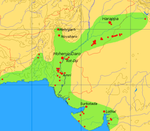History of Indus River (History)
History
Paleolithic sites have been discovered in Pothohar near Pakistan's capital Islamabad, with the stone tools of the Soan Culture. In ancient Gandhara, near Islamabad, evidence of cave dwellers dated 15,000 years ago has been discovered atMardan.[citation needed]

 The major cities of the Indus Valley Civilization, such as Harappa and Mohenjo-daro, date back to around 3300 BC, and represent some of the largest human habitations of the ancient world. The Indus Valley Civilization extended from across Pakistan and northwest India, with an upward reach from east of Jhelum River to Ropar on the upper Sutlej. The coastal settlements extended fromSutkagan Dor at the Pakistan, Iran border to Kutch in modern Gujarat, India. There is an Indus site on the Amu Darya at Shortughai in northern Afghanistan, and the Indus site Alamgirpur at the Hindon River is located only 28 km (17 mi) from Delhi. To date, over 1,052 cities and settlements have been found, mainly in the general region of the Ghaggar-Hakra River and its tributaries. Among the settlements were the major urban centers of Harappa and Mohenjo-daro, as well as Lothal, Dholavira, Ganeriwala, and Rakhigarhi. Only 90-96 of the over-800 known Indus Valley sites have been discovered on the Indus and its tributaries. The Sutlej, now a tributary of the Indus, in Harappan times flowed into the Ghaggar-Hakra River, in the watershed of which were more Harappan sites than along the Indus.
The major cities of the Indus Valley Civilization, such as Harappa and Mohenjo-daro, date back to around 3300 BC, and represent some of the largest human habitations of the ancient world. The Indus Valley Civilization extended from across Pakistan and northwest India, with an upward reach from east of Jhelum River to Ropar on the upper Sutlej. The coastal settlements extended fromSutkagan Dor at the Pakistan, Iran border to Kutch in modern Gujarat, India. There is an Indus site on the Amu Darya at Shortughai in northern Afghanistan, and the Indus site Alamgirpur at the Hindon River is located only 28 km (17 mi) from Delhi. To date, over 1,052 cities and settlements have been found, mainly in the general region of the Ghaggar-Hakra River and its tributaries. Among the settlements were the major urban centers of Harappa and Mohenjo-daro, as well as Lothal, Dholavira, Ganeriwala, and Rakhigarhi. Only 90-96 of the over-800 known Indus Valley sites have been discovered on the Indus and its tributaries. The Sutlej, now a tributary of the Indus, in Harappan times flowed into the Ghaggar-Hakra River, in the watershed of which were more Harappan sites than along the Indus.
Most scholars believe that settlements of Gandhara grave culture of the early Indo-Aryans flourished in Gandhara from 1700 BC to 600 BC, when Mohenjo-daro and Harappa had already been abandoned.
The word "India" is derived from the Indus River. In ancient times, "India" initially referred to those regions immediately along the east bank of the Indus, but by 300 BC, Greek writers including Megasthenes were applying the term to the entire subcontinent that extends much farther eastward.[6]
The lower basin of the Indus forms a natural boundary between the Iranian Plateau and the Indian subcontinent; this region embraces all or parts of the Pakistani provinces Balochistan, Khyber Pakhtunkhwa, Punjab and Sindh and the countries Afghanistan and India. It was crossed by the invading armies of Alexander, but after his Macedonians conquered the west bank—joining it to the Hellenic Empire, they elected to retreat along the southern course of the river, ending Alexander's Asian campaign . The Indus plains were later dominated by the Persian empire and then theKushan empire. Over several centuries Muslim armies of Muhammad bin Qasim, Mahmud of Ghazni, Mohammed Ghori, Tamerlane and Babur crossed the river to invade the inner regions of the Punjab and points farther south and east.
Comments
Post a Comment